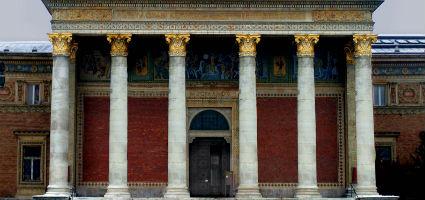2024. September 16. Monday
Kunsthalle - Budapest
 |
Address: 1146, Budapest Dózsa György út 37.
Phone number: (1) 460-7000, (1) 363-2671
E-mail: info@mucsarnok.hu
Opening hours: Tue-Wed 10-18, Thu 12-20, Fri-Sun 10-18
|
Museum tickets, service costs:
|
Ticket for adults
|
1200 HUF
|
|
|
Ticket for adults
(valid for the Kunsthalle and the Ernst Museum)
|
1400 HUF
|
|
|
Group ticket for adults
(from over 10 people)
|
800 HUF
|
/ capita
|
|
Ticket for students
(EU citizens from the age of 6 to 26 )
|
600 HUF
|
|
|
Ticket for students
(valid for the Kunsthalle and the Ernst Museum, 6-26 years of age)
|
700 HUF
|
|
|
Group ticket for students
(from over 10 people)
|
400 HUF
|
/ capita
|
|
Ticket for pensioners
(valid for the Kunsthalle and the Ernst Museum, 62-70 years of age)
|
700 HUF
|
|
|
Ticket for pensioners
(EU citizens from the age of 62 to 70)
|
600 HUF
|
|
|
Ticket for families
(1 adults + 2 children)
|
1800 HUF
|
/ family
|
|
Ticket for families
(2 adults + 2 children)
|
2400 HUF
|
/ family
|
Károly Kós (1883–1977) was an architect whose wide-ranging architectural activities spanned much of the 20th century and many of its history-making periods. At the beginning of his career, before the First World War, as a leading figure of the so-called 'Young Ones', he created several masterpieces of Hungarian architecture (the pavilions of the Budapest Zoo and Botanical Garden, the Roman Catholic Church in Zebegény, the Szekler National Museum in Sfântu Gheorghe), and later built a home for himself and his family in Staná, in the Kalotaszeg region of Transylvania. Simply known as Crow Castle, his house is now a place of pilgrimage.

After his works during the First World War (the decorative designs for the coronation ceremony of Charles IV, the design of Archduke Joseph's hunting lodge) and his study trip to Turkey, he was active in Transylvanian politics, and from 1925 he worked supporting f the Hungarian minority through his architectural, literary, monument protection and teaching work amongst others. In the period between the two world wars, one of the centres of his activities was Sfântu Gheorghe, where he participated in numerous architectural, ethnographic and community projects in collaboration with the community of the Szekler National Museum, which he designed and built in 1912. Many of Károly Kós' public buildings and town houses were built in this town.
In parallel with the design of his own house, his writings and plans also feature the figure of a farmer who cultivates the Kalotaszeg landscape in every possible sense - and, if necessary, uses every means to protect it. Kós has defined the concept of the cultural landscape of Kalotaszeg and Transylvania, and put his talent and knowledge at its service. He designed many buildings for the people of villages and small towns, as well as for the Reformed Church, and his work has influenced the lives of generations. Although he remained out of the mainstream of the architectural world, his work has been remarkably consistent and exemplary to this day.
The exhibition presents the young architect's early masterpieces with the help of original plans, archive photographs, contemporary illustrations and documents. Through contemporary publications and his own writings, his vision and achievements in the multidisciplinary field of community organisation are revealed.
The works in this exceptionally rich oeuvre show that Károly Kós' vision of landscape and settlement is in fact a relationship between nature and humankind. His work is an artistic expression of one of the last experiments in craftsmanship at the beginning of the 20th century. Kós warns us that nature and humanity do not exist in separate worlds but are an integral part of the universe which can only be maintained by respecting nature.

After his works during the First World War (the decorative designs for the coronation ceremony of Charles IV, the design of Archduke Joseph's hunting lodge) and his study trip to Turkey, he was active in Transylvanian politics, and from 1925 he worked supporting f the Hungarian minority through his architectural, literary, monument protection and teaching work amongst others. In the period between the two world wars, one of the centres of his activities was Sfântu Gheorghe, where he participated in numerous architectural, ethnographic and community projects in collaboration with the community of the Szekler National Museum, which he designed and built in 1912. Many of Károly Kós' public buildings and town houses were built in this town.
In parallel with the design of his own house, his writings and plans also feature the figure of a farmer who cultivates the Kalotaszeg landscape in every possible sense - and, if necessary, uses every means to protect it. Kós has defined the concept of the cultural landscape of Kalotaszeg and Transylvania, and put his talent and knowledge at its service. He designed many buildings for the people of villages and small towns, as well as for the Reformed Church, and his work has influenced the lives of generations. Although he remained out of the mainstream of the architectural world, his work has been remarkably consistent and exemplary to this day.
The exhibition presents the young architect's early masterpieces with the help of original plans, archive photographs, contemporary illustrations and documents. Through contemporary publications and his own writings, his vision and achievements in the multidisciplinary field of community organisation are revealed.
The works in this exceptionally rich oeuvre show that Károly Kós' vision of landscape and settlement is in fact a relationship between nature and humankind. His work is an artistic expression of one of the last experiments in craftsmanship at the beginning of the 20th century. Kós warns us that nature and humanity do not exist in separate worlds but are an integral part of the universe which can only be maintained by respecting nature.



